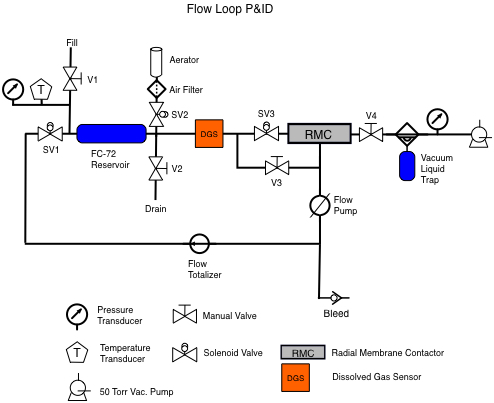Next-generation Spacecraft Coolant
Carthage students supported the Purdue University Flow Boiling and Condensation Experiment currently manifested for launch to the ISS in 2020. The Carthage team developed and flew an experiment to test the capability of radial membrane filters to remove oxygen from a perfluorohexane-based coolant in low gravity.
Experiment Background
The current method of environmental cooling on the International Space Station is a two-fluid, single-phase system in which water is circulated through Station to absorb heat, and then brought into conductive contact with anhydrous ammonia circulating in pipes that are exposed to the external space environment. The ammonia transfers the heat load from the water to space where it is radiated away.
In general, the use of a single-phase coolant loop, such as the one currently on the ISS, poses several problems that result in lowered cooling efficiencies. The fluid in contact with the external space environment (the ammonia) must have its contact time monitored and limited to prevent it from freezing. In the case of the liquids presently employed on the station, ammonia has a less than ideal heat capacity and is not ideal for quickly absorbing and radiating heat on station. Finally, the use of ammonia poses health risks to crewmembers in the event of leaks.

An alternative, more efficient, approach is to use a liquid with a much lower boiling temperature in a two-phase cooling system. In two-phase systems, coolant has a low enough boiling temperature that when it absorbs heat from the station it will begin to boil. The vapors are then cycled outside the station, where they condense back into a liquid that can be cycled back into the station for reuse. The two phase system is, in general, more efficient than a single phase cooling system. However, during the boiling and condensation processes gas dissolves into the liquid. This process reduces the heat capacity of the fluid, making the cooling less efficient. Therefore, a method of degassing coolant in microgravity environments is needed before two-phase cooling systems can be practically implemented. The purpose of the current experiment is to test a method of degassing a next-generation coolant using a radial membrane contactor. We measure the rate atmospheric oxygen removal in a saturated liquid coolant and compare these measurements to those obtained in ground testing.
Flight Campaigns
2013 NASA SEED, 2013 GRC Research Flights
Student Involvement
Danielle Weiland, John Robinson, Steven Mathe, Eli Favela, Kevin Lubick
Related Presentations
Degassing of FC-72 in Microgravity (Poster)
Reports and Publications
Degassing of FC-72 in Microgravity
Weiland, D., Crosby, K.M., Hall, N., Proceedings of the 23rd Annual Wisconsin Space Grant Consortium (2013).

